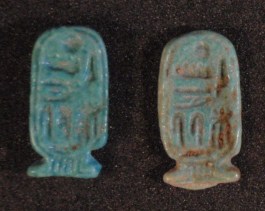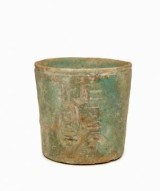In ancient Egypt and Sudan groups of objects were buried at specific points, such as the corners of buildings, during foundation rituals to mark the construction of temples and tombs – rather like symbolic ground-breaking ceremonies at the beginning of the construction of modern buildings. These ‘foundation deposits’ were deliberately chosen to symbolically ensure the effectiveness and longevity of the building, and included faience plaques in the form of sacrificed animals, model tools, pottery and basketry.
Foundation deposits take the form of different sized pits, which were often lined with mudbrick. During his excavation of the 12th Dynasty pyramid temple of Senwosret II at Kahun, W. M. F. Petrie found a foundation deposit and stated:
In the middle of the temple area a hole 31 inches square was excavated in the rock about four feet deep, to contain the foundation deposits. Into this the four sets of objects [model tools] were thrown, without any arrangement or order.
Although foundation deposits became gradually more common during the Old and Middle Kingdoms, they reached the height of their popularity during the New Kingdom (c. 1550-1070 BC). Manchester Museum’s collection includes a range of deposits from different sites and periods, including over 100 faience plaques symbolising offerings in the form of parts of oxen, ducks, flowers and fruit, like these plaques of sacrificed headless oxen [Acc. No. 1560, left]. We chose to display most of these – many for the first time – in the new Egyptian Worlds gallery, to emphasise their quantity.
Sometimes faience plaques with the name of the pharaoh in a cartouche were also buried in the foundation deposit – also a useful dating tool – such as these examples found in a foundation deposit at the temple of Ramesses II in Western Thebes (the Ramesseum) preserving the name of Ramesses II [Acc. No.1846a-d]. We also have a group of copper model tools, including these model hoes, from a foundation deposit at the temple of Queen Tausret in Western Thebes [Acc. No. 1595].
Foundation deposits have also been found beneath royal pyramids in Sudan, including these beautiful faience cups preserving the names of the Kushite kings Aspelta [Acc. No. 8581] and Anlamani [Acc. No. 8579], both excavated by the Harvard-Boston expedition from the royal pyramids at the site of Nuri in Sudan.
– Anna
Anna Garnett is Trainee Curator in Egypt & Sudan at the British Museum and Manchester Museum. Follow her blog here.




